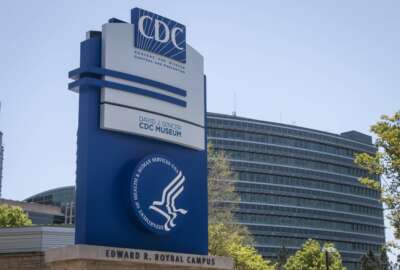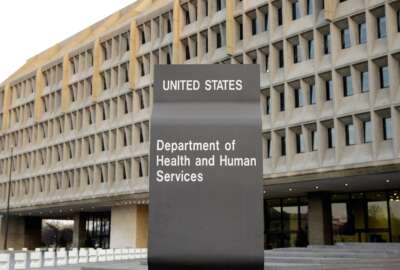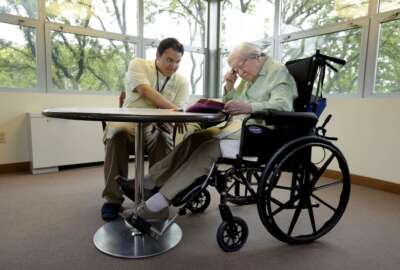Hubbard Radio Washington DC, LLC. All rights reserved. This website is not intended for users located within the European Economic Area.
Nursing homes reveal need for CDC to improve national data reporting site
For nearly 20 years, the Centers for Disease Control and Prevention (CDC) has operated a data gathering site, called the National Healthcare Safety Network. In ...
For nearly 20 years, the Centers for Disease Control and Prevention (CDC) has operated a data gathering site, called the National Healthcare Safety Network. In 2020, CDC made it mandatory for nursing homes to report COVID cases. Suddenly thousands of nursing homes had to enroll in the network. It didn’t go well, but things have improved since then. For the latest, the Federal Drive with Tom Temin talked with Health and Human Services Assistant Regional Inspector General, Marshall Allen.
Interview Transcript:
Tom Temin And tell us about this network and what really happened when they made it mandatory for nursing homes to report health data?
Marshall Allen Well, the CDC has what’s called the National Health Care Safety Network, and NHSN is the acronym for it. It’s a data gathering tool to track health care acquired infections. And it’s been typically used more for hospitals. But when the pandemic hit, CMS made it mandatory for nursing homes to report to NHSN. And they had to report all types of COVID data. So, they had to report suspected COVID cases, total COVID deaths, PPE, hand hygiene, ventilator capacity, all types of information about COVID now had to be gathered. And this was in May of 2020 when this requirement went into place. And I know your listeners will remember that was the absolute heat of the pandemic. I mean, this was a real crisis moment. And so, this previously voluntary reporting for nursing homes now became mandatory. And CDC had a massive challenge on its hand. How do you enroll thousands of nursing homes in a matter of weeks to accurately gather and report this really crucial information?
Tom Temin Well, it sounds like it must be, frankly, a primitive system, because online enrollment for applications now is a part of American life, pretty widespread. And there are sites that, you know, 10,000 people sign up an hour and get an account. What was the difficulty?
Marshall Allen Yeah, I could see why you’d say that, but it’s actually a pretty complicated system. And then also, don’t underestimate the stress that the nursing homes were under at this time. Nursing homes are notoriously short staffed and trying to juggle a lot of different things at the moment. And don’t forget, COVID was really unknown at this time. So, you have these nursing homes where they have very high turnover, not a lot of trained staff having to create a login for this system. And I know it should seem really simple, but process was a little convoluted. Like specifically at one point in the process they had to upgrade their security access and they actually had to send in some actual like hard copy documentation to verify their identities because they didn’t have a quick access kind of immediate identity kind of thing built into the system. So, it was something that had to happen really fast under a huge amount of stress with the nursing homes not being well trained or well-staffed.
Tom Temin Right. So, it’s partly a systemic issue with the way nursing homes are organized and the kind of staffing they have. But it also sounds like there was a little bit of a process issue that CDC needed to fine tune.
Marshall Allen Yes, definitely. And so, they sent out a lot of guidance and they held a lot of webinars. But remember, this all happened in a matter of weeks. And so, they had to add to the system too. They had to create in the new system the capacity to gather all this data about COVID that had not previously been gathered before. And so, they did webinars. They did everything they could to get people enrolled, but they had about 12,000 nursing homes enrolled. Like really all at once. And so there were a lot of challenges with the enrollment. Getting people logged in was a challenge to help. Having people understand the guidance was a challenge. And one of the biggest challenges was that the helpdesk I mean, you can imagine the helpdesk for NHSN had never seen anything like this before, and suddenly they have thousands of nursing homes needing assistance. And the way the helpdesk was created, it did not have any phone assistance or live chat ability. It was all email. And so, you know, you have nuanced questions about the nursing home might have needed to know, what do I need to report? How do I need to report it? How do I get logged in? I forgot my password. I mean, you can imagine all these calls to the helpdesk, thousands of them at once. And so, it created a massive backlog because they didn’t have live support. It just made it really difficult to get these things answered over email.
Tom Temin And did this enrollment actually get accomplished in time to inform understanding of COVID in nursing homes?
Marshall Allen It did. And I mean, that’s pretty remarkable. You know, 12,000 nursing homes got enrolled rapidly. I mean, there were backlogs, there were hassles, there were frustrations. But they did get enrolled. They did report the data. The one other thing that we found, and this went into our recommendations, was all the data reported to NHS and is self-reported data. And there are some QA checks done on the data. But we asked nursing homes what their confidence was. We did a survey of about 200 nursing homes, and we also did interviews with nursing homes, and we asked them what their confidence was about, the completeness and the accuracy of the data that they were reporting to NHSN. And about 1 in 4 said they did not have confidence in the completeness and accuracy of the data. And so, one of our recommendations to CDC was to bump up their QA checks, you know, give better guidance and documentation on the front end, and then also check the data on the back end. You know, have a QA process in place so that you can really verify the data that you’re gathering is really accurate.
Tom Temin We’re speaking with Marshall Allen. He’s assistant regional inspector general at Health and Human Services. And now that we are here in 2024, you did this work, this inspection of this system in late 23. Why now?
Marshall Allen Yeah, NHSN has changed a lot. And we even asked the nursing homes whether things had improved since the height of the pandemic. And they had improved, but they still had challenges even when we were doing our data gathering. This was, two years after the height of the pandemic, when we were talking to them. They still had challenges with the reporting, with the different, different aspects of the system. And the reporting has been reduced. Now they’re still gathering vaccine data from the nursing homes. But the other thing CDC is talking about doing is expanding the use of NHSN. And so, as they look forward to expanding the use of it as they continue to gather this vaccine data, it’s important that they take these steps. You know, we recommended. Another thing we recommended is that they give some live support, whether it’s chat or telephone support, on their help desk, just so that the users don’t get frustrated when they’re trying to get that guidance.
Tom Temin And what is the current population of reporting entities now on the network?
Marshall Allen I think it’s about 15,000 nursing homes reporting. I don’t know the number of hospitals that was outside the scope of what we looked at. I know they added 12,000, and I believe they had about 3000 who are already voluntarily enrolled before the pandemic.
Tom Temin So fair to guess, there’s tens, maybe 20s of thousands of hospitals that had already been reporting for some time.
Marshall Allen Yeah, there are fewer hospitals in the nursing homes, so there probably aren’t that many. But yeah, hospitals have been reporting to NHSN for years and they report things like, you know, C-diff infections, MRSA infections, central line infections, all that type of data is really important. But another thing with the quality improvement, I mean, the hospitals were outside the scope of what we’re doing, but the hope is that if they can improve the QA checks for the nursing homes, that maybe that would also affect the QA checks for the hospital data, too.
Tom Temin And maybe they could have hospitals that are good at this, deputized to teach the new entities how to how to get into the system and how to use it.
Marshall Allen Definitely. And I think one of the challenges for the nursing homes is the turnover rates. You know, the staffing is at a crisis level in nursing homes right now. And a big part of that is just turnover of the staff. And that was something we found with everyone we talked to. You can train one person to be the key point person for the NHSN reporting, but then that person might leave and then you have to train someone new. And so, the turnover in nursing homes is just a real challenge for keeping this system up to date.
Tom Temin And you said in the report that the COVID reporting is about to expire, that requirement for the nursing homes. And then you told me that there is going to be an expansion of entities reporting. So, what is next for the network?
Marshall Allen Well, we don’t know for sure what that will be. And the CDC officials didn’t tell us what that would be. But the vaccine data is still COVID 19. Vaccine data is still required to be reported to NHSN by nursing homes. And then they have talked about expanding it, but they weren’t specific about what that would look like.
Tom Temin Because if hospitals routinely report some of these infections and so forth, that kind of stuff happens in nursing homes all the time.
Marshall Allen Definitely, there’s I mean, there’s a lot of ways NHSN could be used. It’s a really valuable tool.
Tom Temin What other recommendations did you have and what was CDC’s reaction so far?
Marshall Allen Well, so we had three recommendations. The first one was to add some live chat, live support to the helpdesk by phone, person or someone on live chat, just so specific questions could be answered in real time. They partially concurred with that. You know they’re required to concur or non-concur on this one. They partially concur. They said that they have been making a lot of improvements and we responded to that. While we still think you know that you should add the live support. And then the other two were related to the quality of the data, one recommendation was to improve the guidance that they were providing to people as they enrolled. CDC concurred with that. And then the other one they concurred with was improving the quality assurance process so that they could be confident that the data that’s being reported is complete and accurate.
Copyright © 2024 Federal News Network. All rights reserved. This website is not intended for users located within the European Economic Area.
Tom Temin
Tom Temin is host of the Federal Drive and has been providing insight on federal technology and management issues for more than 30 years.
Follow @tteminWFED
Related Stories
Related Stories
-
Some new ideas to make the CDC more effective in pandemics Agency Oversight





